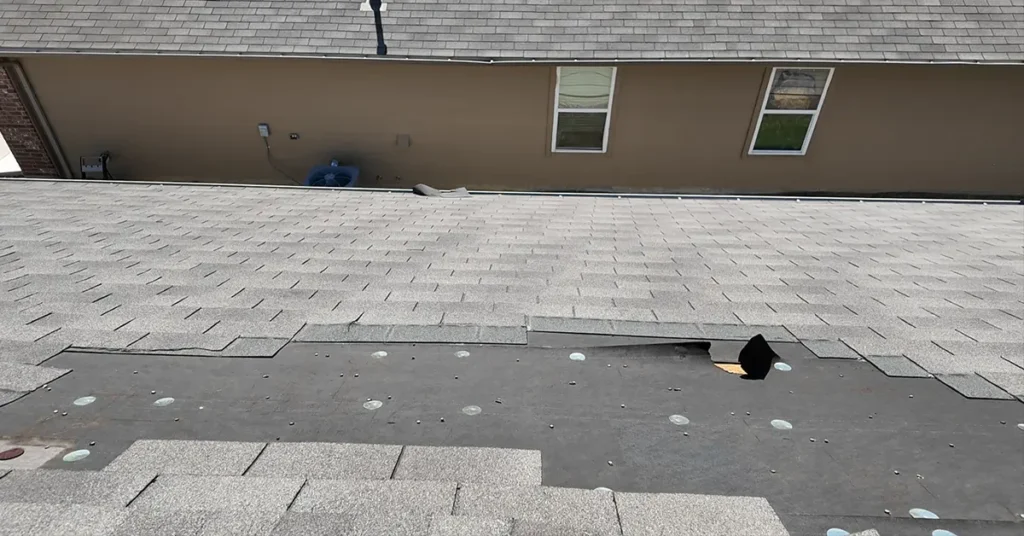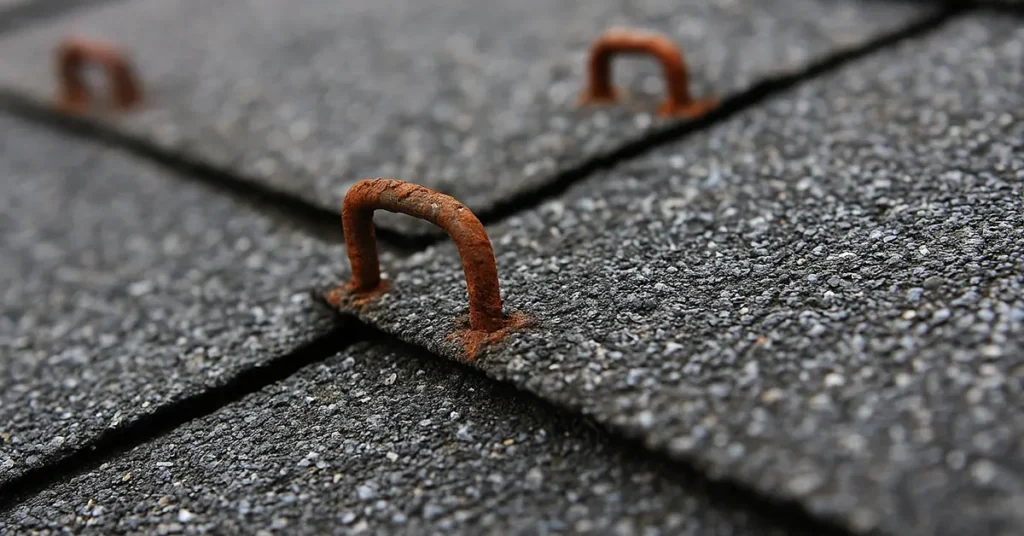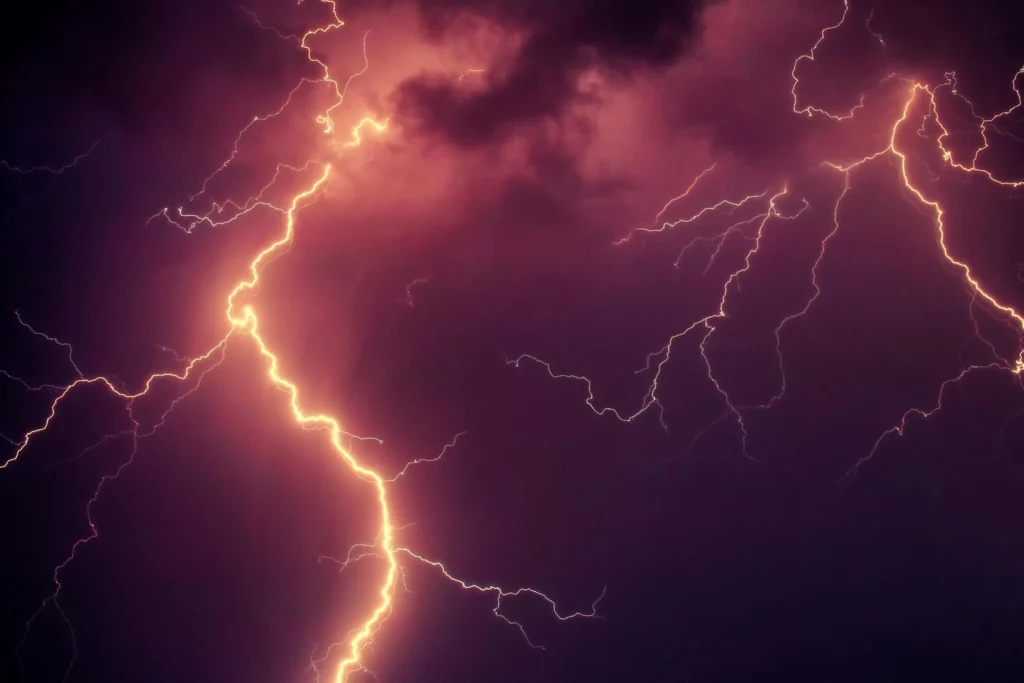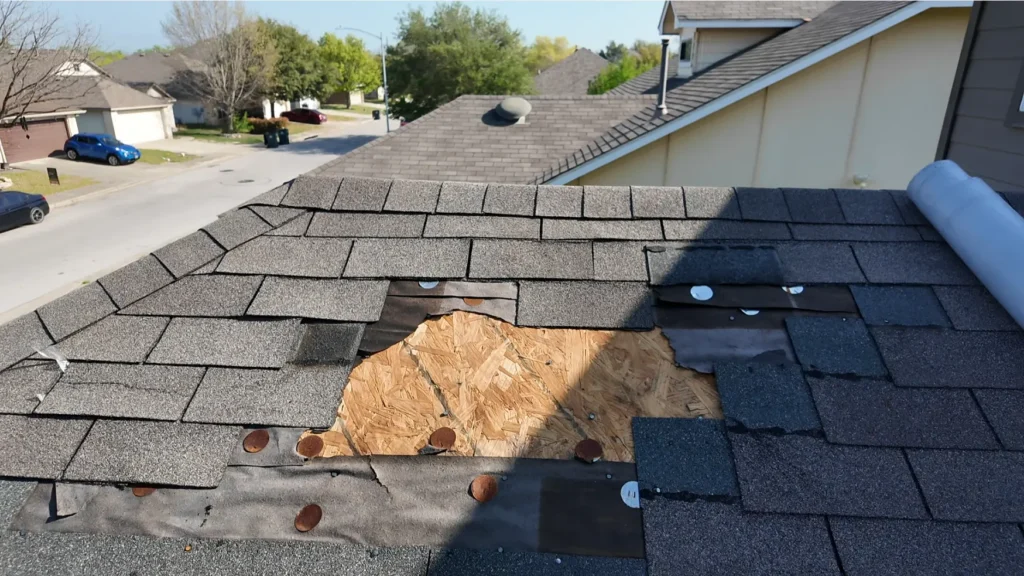It should’ve held.
The roof looked solid, the shingles appeared intact, and the install was only a few years old. But when the storm rolled through Central Texas, it didn’t stand a chance. Shingles flew off. Water poured in. Damage piled up.
The reason? High nailing.
This wasn’t bad luck. It wasn’t an aging roof. This was an avoidable mistake that caused a wind damaged roof to fail when it mattered most.
And it happens every single day.
Let’s break down how something as small as improper nail placement can be the difference between a roof that holds—and a roof that’s ripped apart by wind.
High Nailing: The Silent Killer Behind Every Wind Damaged Roof
High nailing is when roofers place nails above the manufacturer’s specified nail line—the reinforced zone designed to lock down each shingle.
Miss that line? You miss the strength.
When wind hits a roof, the pressure lifts from the bottom edge. If nails are too high, the shingle tears free. And during Texas storms, that’s all it takes to turn a solid roof into a shredded mess.
Every week, we inspect a wind damaged roof that failed for one simple reason: the nails were in the wrong spot.
How Shingle Manufacturers Are Trying to Stop Wind Damaged Roofs
Manufacturers know the problem. That’s why many now add a second visual nail line—making it easier for roofers to get it right.
But lines don’t fix laziness. They don’t fix shortcuts. And they don’t fix crews who rush jobs without verifying every nail is locked in the reinforced zone.
If your roofer still misses? That’s not the product’s fault. That’s a roofing fail—one that leaves you with a vulnerable, wind damaged roof.
Correct Nailing vs. High Nailing: The Visual Difference
Let’s make it clear.
Correct Nailing:
Nails go through the nail line
Nails penetrate the deck fully
Each nail grabs two layers of shingle for maximum hold
Proper spacing per wind zone specs
High Nailing:
Nails sit above the bond zone
Only one shingle layer is anchored
No reinforcement = easy lift-off
Weak hold leads to shingle blow-offs in storms
This difference is why we do photo documentation with every job. If your shingles aren’t nailed right, your roof won’t survive. Especially if you already have a wind damaged roof from past storms.
How Improper Nailing Causes Wind Damage and Roof Failure
Wind pressure works from the bottom edge of a shingle upward. If the seal is broken and the nails are too high, the wind gets under… and it’s game over.
It starts with one tab.
Then two.
Then a whole slope of your roof tears off like peeling duct tape from drywall.
We’ve seen it hundreds of times on storm damage roof repair calls. The pattern is clear: high nailing = weak shingles = wind damaged roof.
And guess what? Insurance companies often deny these claims. Why? Because high nailing violates install standards—meaning your claim can be denied due to “improper installation.”
How to Spot a Wind Damaged Roof Before It’s Too Late
You don’t need to wait until water’s dripping from the ceiling. Here’s how to catch the problem early:
✅ Check for lifted shingles or missing tabs after a storm
✅ Look for creases across the face of shingles—signs they’ve been bent by wind
✅ Ask your roofer: Where do you place nails, and how do you verify proper placement?
✅ Demand install photos showing nail placement along the correct line
✅ Schedule a roof inspection in Texas after every major storm
If you already had wind damage once? The next storm could be the one that takes it all down.
Why Every Wind Damaged Roof Needs a Pro-Level Inspection
You can’t eyeball nail placement from the ground. And most homeowners aren’t climbing the roof with a shingle spec sheet.
That’s why a professional roof inspection in Texas is essential—especially after storms.
At Texas Roof Damage, we offer FREE inspections that include:
Full photo documentation of your nail lines
Drone footage to spot lifting and shingle blow-offs
Brittle shingle testing to prove repairability
Support for your insurance claim if you’re denied
Same-day reporting so you know where you stand—fast
We specialize in identifying the small install errors that lead to massive wind damage.
Homeowner Guide: What to Ask Your Roofer to Avoid Roofing Fails
You don’t have to be a roofer to protect your home. Ask these simple questions:
Do you follow manufacturer nail line specs?
Can you show me photos of nail placement?
Do you double-check install quality before shingle overlap?
Will I get drone/video evidence of work completed?
What’s your process for ensuring a secure roof installation that resists wind?
If they dodge these? Call someone else.
Your roof isn’t just shingles. It’s your first line of defense against the elements. A wind damaged roof from poor nailing shouldn’t be your learning moment.
Already Have Wind Damage? Here’s What to Do Next
If you’ve already seen shingle lift, or you suspect wind got under your roof, don’t wait.
A wind damaged roof gets worse every time the wind blows. Even if the shingles are still attached, they may have lost their seal—or are barely holding on.
Here’s your next move:
Book a roof inspection in Texas with a trusted contractor
Document everything—before calling insurance
Avoid patch jobs if the roof is beyond repair
Use photos to push back if your roof claim was denied
Let experts handle your storm damage roof repair the right way
We’ve helped hundreds of homeowners turn around claims after insurance lowballed them—or denied them outright.
Don’t Let a Wind Damaged Roof Wreck Your Wallet
A missed nail line might seem like a small mistake.
But when the storm hits, it can cost you everything.
If you’re in Central Texas, your roof faces brutal weather year-round. Wind, hail, heavy rain—every flaw is exposed. And the most common cause of roof failure? Nails placed an inch too high.
Don’t leave it to chance.
Book a Free Roof Inspection in Texas with Texas Roof Damage
We’re not just another roofing company. We’re the team behind your roof, your claim, and your peace of mind.
Here’s what you get with Texas Roof Damage:
✅ FREE inspection within 24 hours
✅ Full photo & video documentation
✅ Claim support if your roof claim is denied
✅ One-day replacements after approval
✅ No pressure—just answers
Don’t wait until the next storm takes your roof with it.
Let us inspect your home, document the damage, and protect your investment.
Texas Roof Damage—Serving Central Texas with roofing that holds. Even when the wind doesn’t.




